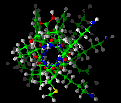 Minimize
Database
Minimize
Database Minimize
Database
Minimize
DatabaseThe Iteration table is always created along with the database. It has eight (8) columns:
1. Method (type = string) 2. SubMethod (type = string) 3. StepsTaken (type = int) 4. EnergyCalls (type = int) 5. InitialMaximumDerivative (type = double) 6. ToleranceMaximumDerivative (type = double) 7. CurrentMaximumDerivative (type = double) 8. TimeInMethod (type = double)The contents of the columns are, respectively:
Additionally, when BFGS is specified as the Newton method, a Misc table is created under the Minimize database, which has one (1) column, called InverseHessian, of type OA_DOUBLE, which contains the inverse Hessian. Only the latest Hessian calculated is kept in the Misc table, meaning that the Misc table has, at most, one (1) row at any time.
BTCL > minimize \
iteration_limit = 20 \
execute +before frequency = 0 \
command = {database handle min_h Minimize.; database print $min_h} \
execute frequency = 1 before = 1 after = 1 \
command = {$min_h print Iteration; print output energy_summary = 1 \
internal_energy = 1 nonbond_energy = 1}
The second execute statement uses the database handle to print
out the Iteration table (in addition to performing other
commands to output energy summaries). A sample output of the Iteration table looks like:
{
Row Method SubMethod StepsTak EnergyCa InitialM Toleranc CurrentM TimeInMe
--- ----------------- ------------- -------- -------- -------- -------- -------- --------
0) SteepestDescent 0 1 71.95 1000.0 71.95 0.3000
1) ConjugateGradient PolakRibiere 4 8 71.95 10.0 7.62 0.3500
2) NewtonMethod NewtonRaphson 3 4 7.62 0.0 0.00 0.5300
}
BTCL > minimize \
iteration_limit = 1000 movement_limit = 0.200 \
sd \
convergence = 1000.0 line_search_precision = 0.100 \
final_convergence = 1000.0 \
cg \
convergence = 10.0 method = polak \
line_search_precision = 0.100 final_convergence = 10.0 \
newton \
convergence = 1.0e-13 method = bfgs \
line_search_precision = 0.900 max_atoms = 200 \
final_convergence = 1.0e-13
BTCL > database handle min_h Minimize.
BTCL > database print $min_h
BTCL > $min_h get i_hess Misc.InverseHessian
BTCL > Utility_CastHessianMatrix i_hess
where Utility_CastHessianMatrix is a BTCL script to cast the inverse
Hessian into a matrix object, called i_hess, which is suitable as
input for other Discover commands.
 Main
access page
Main
access page  Advanced-Use access.
Advanced-Use access. Copyright Biosym/MSI